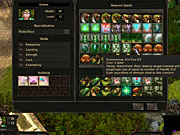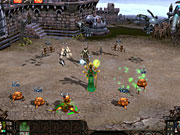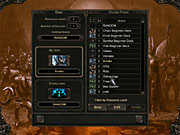Most everyone has at least heard of Magic: The Gathering--it's the strategy game where people duel each other with cards representing various spells and creatures. Each card has unique properties that turn the game into a fight of tactics and sometimes even luck. 2001's Etherlords took that concept and managed to turn it into an entertaining turn-based strategy game. Now developer Nival Interactive has produced a sequel that improves the original game's combat--its best feature--as well as resolves some of the original game's issues. The result is even better than its predecessor, and brings Etherlords' distinctive gameplay up to today's standards.

Etherlords II modifies its predecessor's gameplay to let you control only one hero, from a fixed camera angle. The result feels more like Diablo as you walk through the map and search for things to do. You'll find resources strewn across the land, which you need to purchase more powerful spells. You'll also run into wandering monsters and characters in your adventure. The monsters are a good source of experience points and will often leave you loot in the form of new spells. Non-player characters will assign quests for you to complete.
These quests will advance the story as well as give you missions to accomplish. Each mission has a linear path, but there are often side quests you can embark on that will make your character more powerful. For example, if you go off the path and explore, you may find a shrine that will make a certain creature more powerful. That not only helps you finish the given mission more easily, but is also more rewarding in the grand scheme of things. One mission may make your treants more powerful, while another benefits ticks. This lets you change your strategy with every mission and makes the game much more interesting to play. But perhaps the best new feature in Etherlords II is that you can carry over your hero to the next mission. A big complaint about the first game was that you would spend so much time in every mission, only to lose the experience, spells, and artifacts as you progressed to the next mission. Etherlords II lets you keep everything you have received, so you truly feel like you're building up a powerful hero over the course of the game.

While the adventure portion of the game has been radically changed, the combat has not, though it has been refined. Heroes don't actively fight in the game. Instead, they use something called ether to cast spells from a preconfigured deck. Every spell you find is added to your inventory. You choose 16 of these spells to form an active deck that is used in combat. You start out with five spells when combat is initiated, and your hero receives a new spell at the start of every new turn. Each of these spells has a specified ether casting cost. You gain ether at the start of your turn. You will receive more ether channels as the battle progresses, which allows you to expand your ether pool. Fans of Magic: The Gathering will recognize these mechanics.
A deck can comprise direct combat spells, support spells, and summoning spells. Since your hero can't directly injure the enemy hero, you have to choose a deck of spells that will not only do damage to the enemy, but also protect your own hero. Each faction has a unique set of spells. The Vitals have nature-type spells like treants and plants, while the Synthets have biomechanical spells. Summoned creatures can do direct damage to enemy heroes, or they can block enemy creatures sent to hurt yours. They have an attack and defense rating called power and toughness, respectively. The more powerful creatures require more ether to summon, so they won't come into play until later in a match.
There are many different strategies you can use in a battle. You can summon a swarm of weaker creatures and hope you can kill your opponent quickly. Or you can use spells to make a few creatures even stronger. You can even capture enemy creatures and use them against your opponent. Matches won't last forever because of something called an ether disturbance. If a match drags on too long, both heroes will start sustaining damage every round. So a viable strategy here is to play defensively, raise your health, and let the ether disturbance dispatch your foe.

Your hero isn't completely worthless in battle. You gain hit points with every level, and you can have a specialization. This specialization can support a specific strategy you wish to pursue. If you have a bunch of velos summon spells, perhaps you'll choose the velos twins specialization. It gives you a chance to summon a second velos for free. You can also have up to five innate abilities. One ability gives you a certain percentage of extra hit points, while another will give you a better chance for your specialization to work. You can also set up the abilities for a specific strategy. If you wish to win by killing opponents with ether disturbance, you can choose an ability that will delay your own ether disturbance for a few rounds.
Part of the game is countering your opponent's strategy. You may want unsummon spells if your opponent has a lot of creatures. The problem is that you don't know what spells are in your opponent's deck. This isn't a problem in duels because you can swap out spells in between rounds, but it can be frustrating in the single-player campaign. You'll find yourself saving before every battle because you may need to reload and get the appropriate spells. It can be a tedious process because there isn't a fast way to swap out spells. You have to switch each spell individually.
There isn't much to do alone once you've finished the single-player campaigns. You can fight a duel against a computer opponent using a deck of spells that you choose. The duel runs exactly the same as fights in the campaign. The computer may be a good opponent, but this can get old pretty fast. Your only option to lengthen the game is to play multiplayer duels. This can be fun because fighting against human opponents can lead to satisfying strategic victories. There are new options in Etherlords II for multiplayer. You can enter a blind match where you are both given the same reserve of cards to pick a deck from, or you can enter a tournament with up to eight players. The good thing is that there are actually people playing this game multiplayer. But the bad news is that sometimes you'll square off against an opponent who is much higher in level than you, and you'll be slaughtered quite easily. Overall, multiplayer is a good experience for anyone looking to continue playing Etherlords II.

Etherlords II certainly doesn't look much different from its predecessor. It uses much of the same artwork as Etherlords. The creatures themselves still look quite good, though. They move fluidly, and the spell effects are nice. There are some new units called pale creatures, which you'll see on the battlefield. There really isn't much to the sound in the game; the ambient sounds are forgettable and the voice acting is inconsisent. That's unfortunate because part of what made games like the Heroes of Might and Magic series so fun to play was their audio.
In spite of that, Etherlords II is more or less exactly what a sequel should be to an already great game. The developer listened to fans and critics and modified the gameplay in meaningful ways. At the same time, the core mechanics of the game were improved to complement the change in gameplay. The result is easily recommendable not only to anyone with an interest in collectible card games, including fans of the original, but also to those who enjoy turn-based strategy games with a twist.